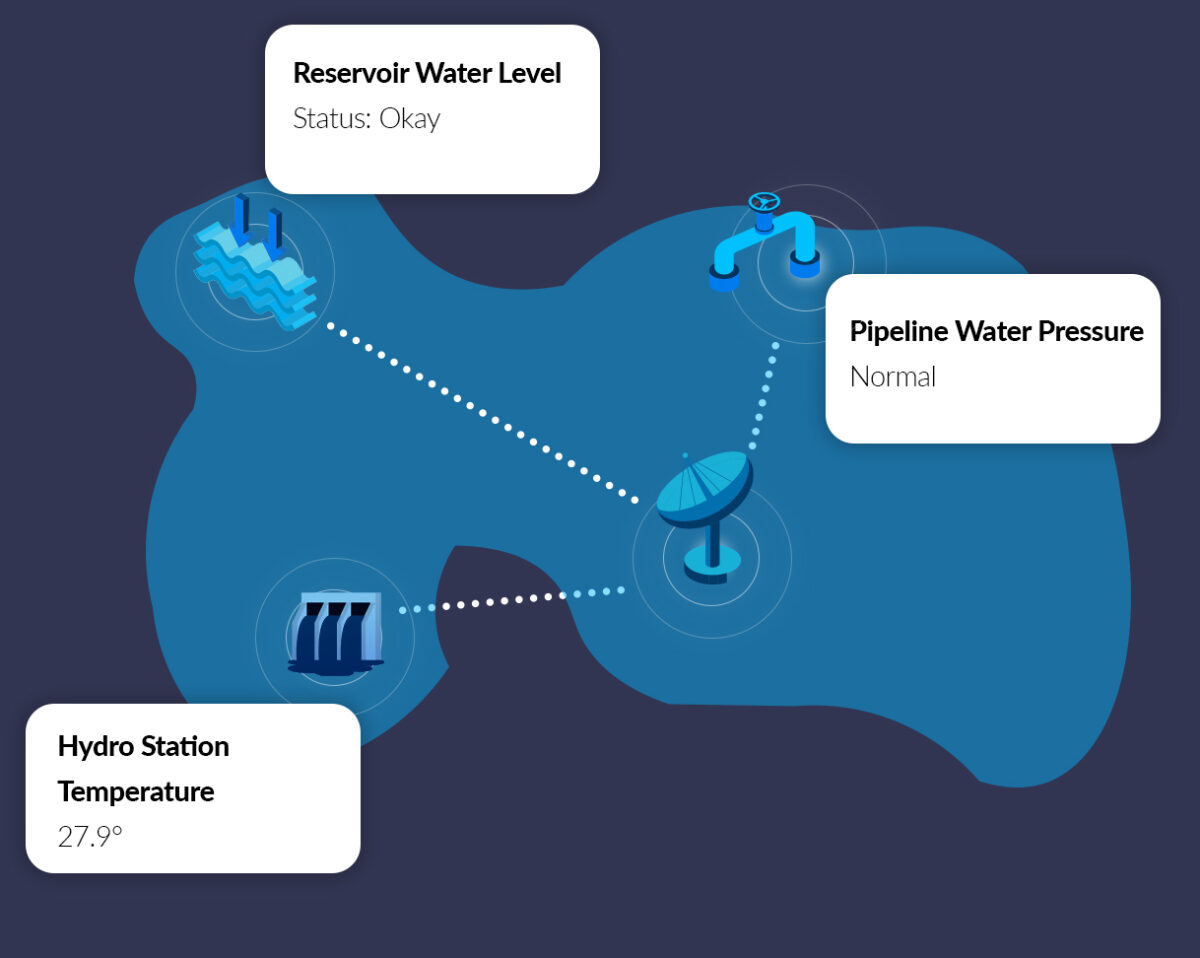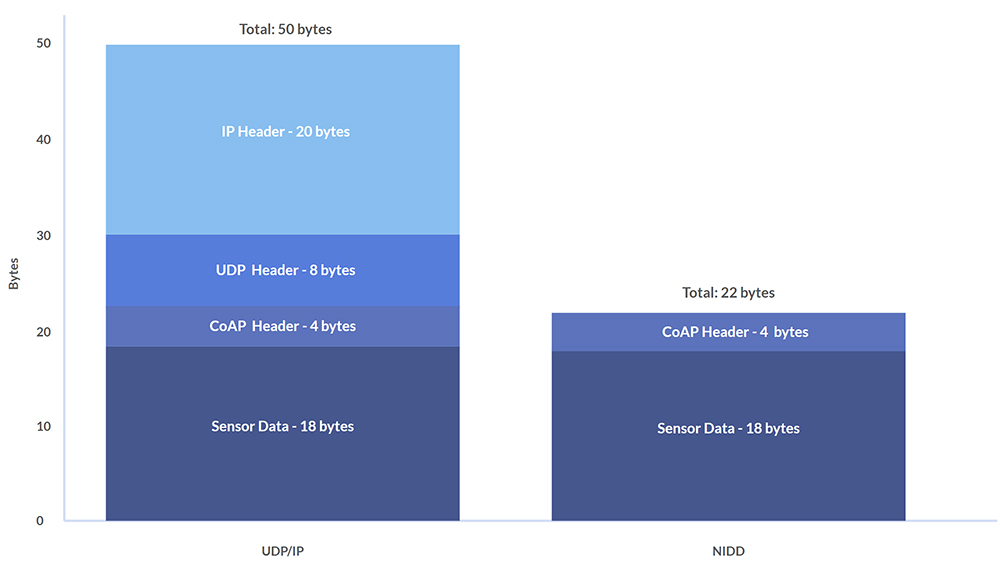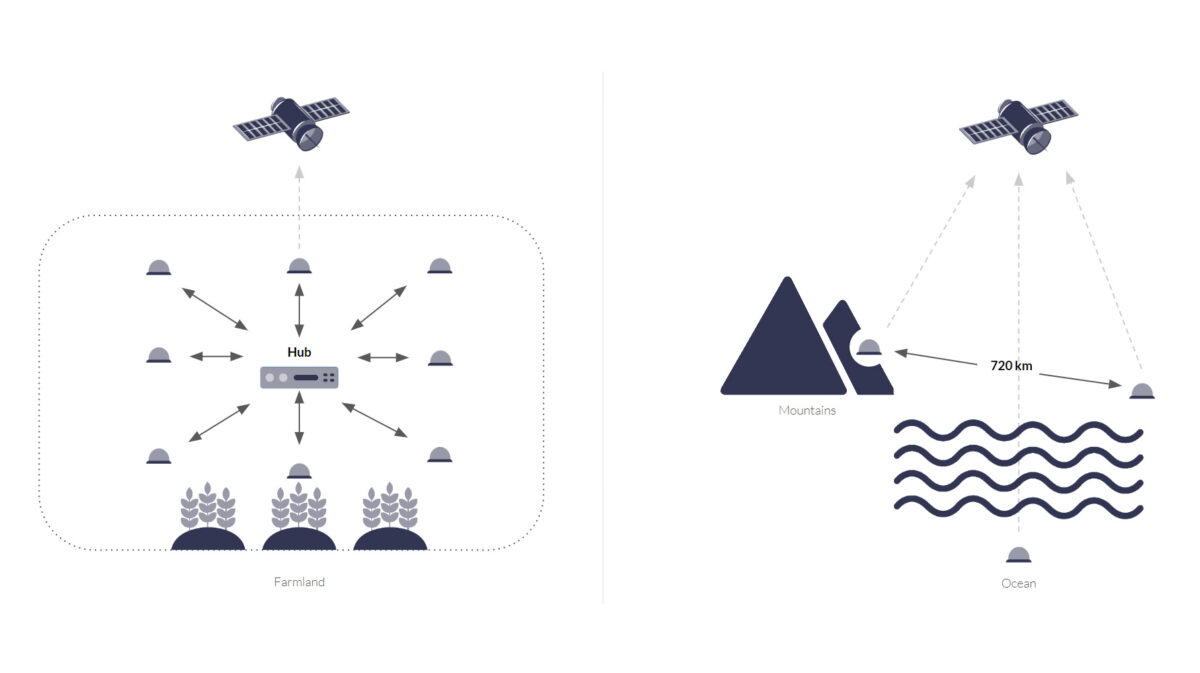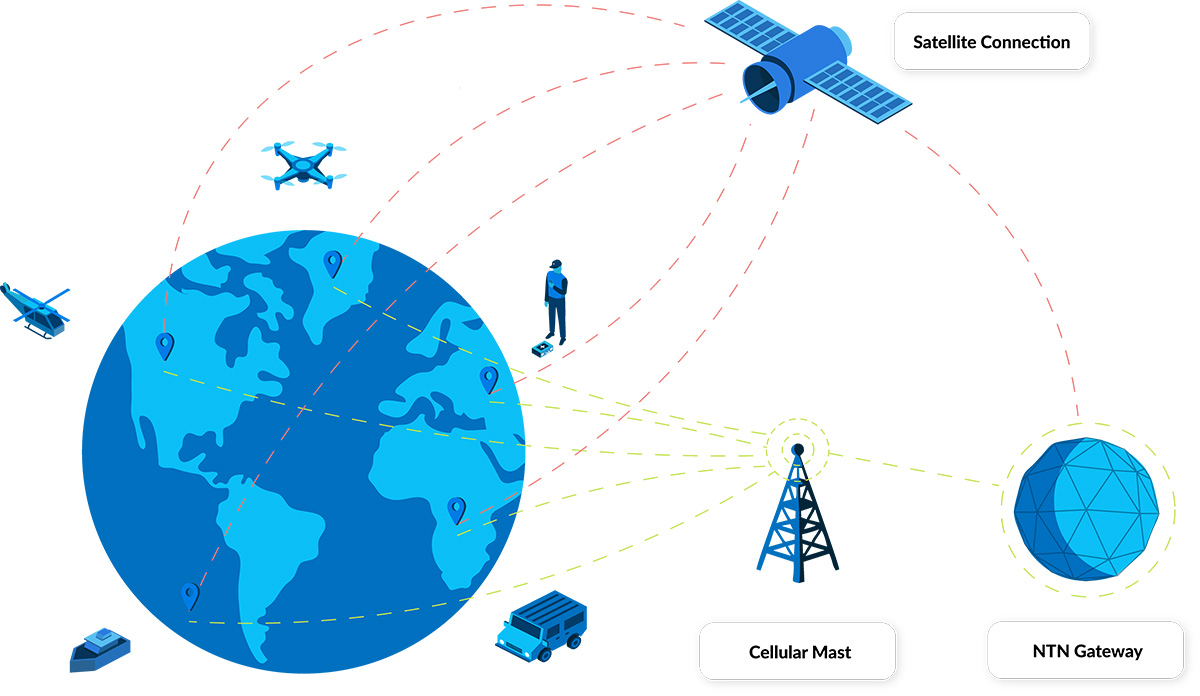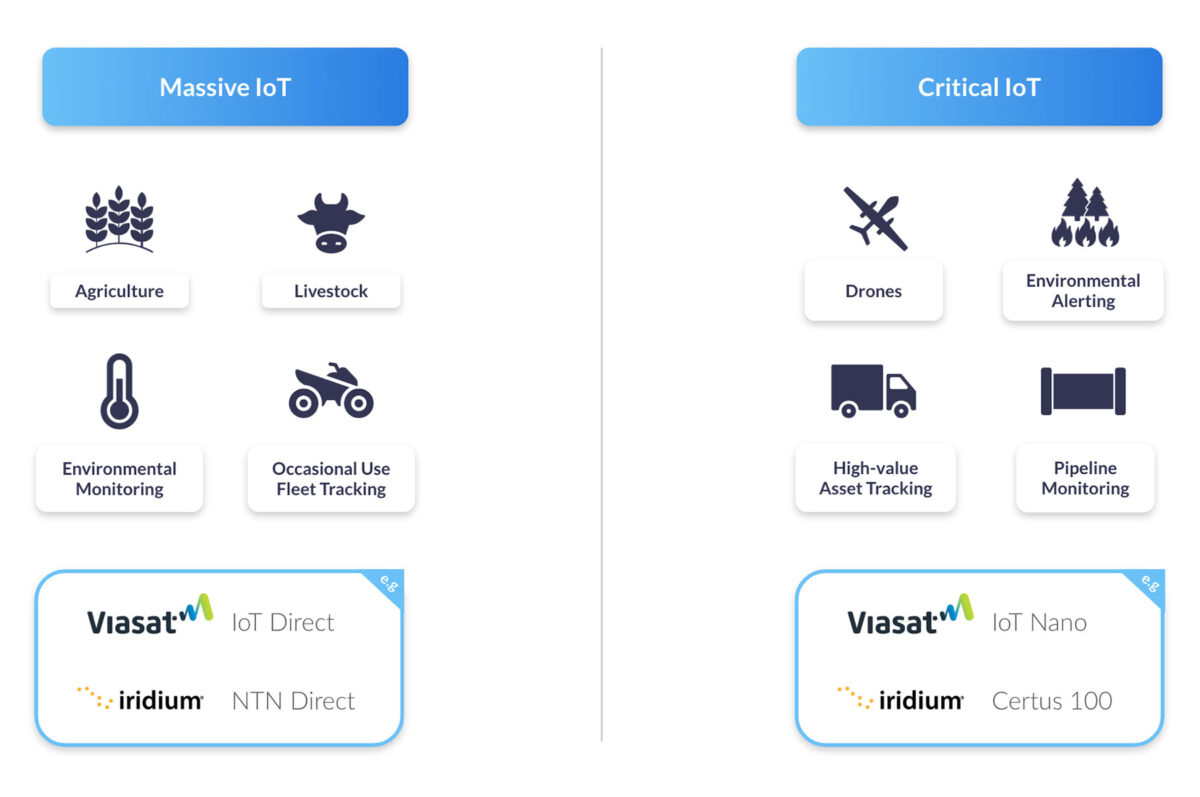On September 4, 2025, we co-hosted a webinar on NTN NB-IoT Uncovered: What It Is, What It Isn’t, and Where It Wins with Viasat. This is emerging technology with a great deal of promise, and we had a large audience, with an accordingly large number of questions! We’ve collated these questions into several topics in this blog post, which we will keep updated as the roadmap progresses.
Quick Links:
- What is the expected cost of hardware (e.g., modem, antenna)?
- What will ongoing connectivity cost, for example at 50 KB per month or one transmission per hour?
- How does NTN NB-IoT communication cost compare to terrestrial NB-IoT and proprietary satellite solutions?
- Does the device include a subscription, and are any licenses required to use the service?
- What are the expected power requirements for receiving and sending messages?
- Will latency in satellite NB-IoT significantly impact battery performance?
- What counts as “small data volumes,” and how is data usage calculated (uplink vs downlink)?
- Is TCP/IP supported, or is NB-IoT limited to other protocols like UDP or NIDD?
- Are message acknowledgements supported, and do they consume billable data?
- What countries and regions are currently covered, and what are the rollout plans?
- Will the service work at sea or in harsh environmental conditions (e.g., offshore, deserts, extreme temperatures)?
- What are the main technical differences between NTN NB-IoT and cellular NB-IoT?
- How does NTN NB-IoT compare to proprietary satellite services like Iridium SBD?
- What frequencies are used, and how do they integrate with mobile networks?
- How does network selection work when both terrestrial and satellite networks are available?
- Is NIDD part of the 3GPP standard and supported by the network?
- Can we manage NTN NB-IoT devices and integrate using existing patterns in Cloudloop?
- What applications are best suited to NTN NB-IoT?
- How suitable is NTN NB-IoT for UAVs, HAPs, or other mobile applications?
- How does NTN NB-IoT compare to Starlink Direct to Cell?
- Could it replace or compete with services like Iridium or Starlink in the future?
- How well does it perform in environments with heavy metal or interference, such as steel plants?
- Does the service require direct line-of-sight, and how does it perform under partial obstruction (e.g., forest canopy)?
- Are the satellites GEO, LEO, or a mix?
Pricing and Licensing
What is the expected cost of hardware (e.g., modem, antenna)?
Hardware pricing varies widely depending on the capabilities your project requires. Some modules are designed purely as basic modems to connect to NTN NB-IoT networks and are relatively inexpensive, but they only provide connectivity.
Products like RockBLOCK RTU are far more than just a connection point. In addition to NTN NB-IoT access, they include:
- Edge processing to handle data locally and reduce transmission frequency (saving airtime and battery life).
- Configurable sensor reading and alerting, so you can trigger transmissions only when thresholds are met.
- A plug-and-play design, enabling faster deployment and simpler integration with cloud platforms like Cloudloop.
Because of this added functionality, RockBLOCK RTU and similar devices sit at a different price point than a simple dongle, but they often reduce overall project costs by lowering airtime usage, extending battery life, and minimizing field maintenance.
In short, the “right” hardware investment depends on whether you need just connectivity or a complete field-ready solution that simplifies operations and scales with your project.
What will ongoing connectivity cost, for example at 50 KB per month or one transmission per hour?
Viasat has not yet published official NTN NB-IoT pricing, but early indications suggest it will be competitive for the specific niche of very small, infrequent data transmissions. Final rates are expected to be announced in Q1 2026.
Because of the complexity and scale of satellite infrastructure, NTN NB-IoT data will not follow the same pricing model as terrestrial NB-IoT. In practical terms, this means far less data for a higher cost, making it best suited to scenarios where devices send tiny payloads, such as tens of bytes per hour, rather than continuous data streams.
When compared to proprietary satellite services, NTN NB-IoT can be more cost effective for ultra-low data volumes (typically below 30-50 KB per month per device). This makes it a strong choice for applications like remote sensors, infrequent tracking, and metering.
Around 50 KB per month, message-based services like Iridium Messaging Transport (IMT) and NTN NB-IoT become roughly equivalent in cost.
Above 50 KB per month, proprietary services like IMT quickly become far more economical, especially for higher data throughput or near-real time applications.
In summary, NTN NB-IoT fills a valuable gap for low data, low power use cases, but it is not simply a continuation of cellular NB-IoT pricing in space. For higher data needs, traditional satellite services remain the better fit.
How does NTN NB-IoT communication cost compare to terrestrial NB-IoT and proprietary satellite solutions?
Satellite NB-IoT is designed for very small, infrequent data transmissions, such as a few tens of bytes per hour or day. Because of the complexity of delivering data over satellites, the cost per kilobyte is much higher than for terrestrial NB-IoT, which benefits from existing cellular infrastructure and is inexpensive for high volume, high frequency data.
For ultra-low data applications, Satellite NB-IoT promises to be more affordable than traditional proprietary satellite services, which are built for higher throughput, always-on connections. However, as data usage rises beyond roughly a few dozen kilobytes per month per device, the cost of satellite NB-IoT can quickly become more expensive, making other satellite solutions like Iridium Messaging Transport, or Viasat IoT Nano, more economical.
In short:
- Terrestrial NB-IoT is the lowest cost option, but only works where there is cellular coverage.
- Satellite NB-IoT fills the gap where coverage is missing, offering lower costs than legacy satellite services for small, infrequent messages.
- Proprietary satellite solutions remain the best fit for higher data volumes, real time control, or truly global coverage.
Does the device include a subscription, and are any licenses required to use the service?
NTN NB-IoT works much like cellular IoT. Devices use a SIM card to authenticate on the network, and subscriptions are managed separately. These can be as short as one active month or discounted for 12 months or longer, depending on your needs.
No additional licenses are required as long as you are using a certified device. If you’re building your own hardware, it must first go through Viasat’s certification process before it can connect to the network.
Power Consumption
What are the expected power requirements for receiving and sending messages?
Final power profiles are still being confirmed, but early testing of devices shows very low power consumption, similar to cellular NB-IoT at the edge of coverage. Typical behavior is short, high-power bursts during transmission, with the device in deep sleep the rest of the time.
- Transmit (TX): Brief bursts at a few hundred milliamps for fractions of a second per message.
- Receive (RX): Much lower current for very short listening periods.
- Deep Sleep: Extremely low standby current between events.
For ultra-low data use cases – such as one small (50-byte) message per day – battery life can be measured in years. Even at one message per hour, multi-year operation is still realistic with careful design, especially when payloads remain small, retries are minimized, and devices have a clear view of the sky.
Tip: Use short, infrequent messages and Non-IP Data Delivery (NIDD) where possible to maximize battery life.
Will latency in satellite NB-IoT significantly impact battery performance?
Not directly. Latency in satellite NB-IoT (typically tens of seconds) affects how long a device stays “awake” waiting for confirmation or downlink data, but it doesn’t require the radio to transmit continuously. Most of the time, the device is idle and consuming minimal power.
Where battery performance can be affected is in retry scenarios. If poor antenna placement or obstructions cause repeated failed attempts, the radio will need to re-send messages, increasing total energy used. This is why clear line of sight and well planned message scheduling are key.
For applications sending small, infrequent messages, latency has little impact on battery life, and multi-year operation remains realistic, even when end-to-end message delivery takes longer.
Data & Protocols
What counts as “small data volumes,” and how is data usage calculated (uplink vs downlink)?
For NTN NB-IoT, small data volumes generally mean 30-50 KB per month per device. This roughly equates to one small message (around 50 bytes) every hour, making it ideal for applications like periodic sensor readings or exception-based reporting.
Data usage is calculated as the total of both uplink and downlink traffic, combined.
- Uplink: Data sent from the device, such as sensor readings or alerts.
- Downlink: Data sent to the device, such as configuration updates or acknowledgements.
In most deployments, uplink traffic dominates, with only small amounts of downlink data needed. However, frequent acknowledgements or commands sent to the device will eat into the monthly budget, so it’s best to minimize downlink usage wherever possible.
Rule of thumb: If your device sends a 50-byte message hourly, you’ll be close to the 30-50 KB/month sweet spot, but adding regular downlink messages or retries can quickly push usage higher.
Is TCP/IP supported, or is NB-IoT limited to other protocols like UDP or NIDD?
TCP/IP is not supported for NTN NB-IoT. By avoiding the heavy overhead of TCP/IP, devices can send and receive data far more efficiently, using fewer bytes per message and significantly reducing power consumption.
Instead, NTN NB-IoT uses lightweight protocols such as UDP and NIDD (Non-IP Data Delivery), which are purpose-built for small, infrequent IoT messages. This means:
- Lower airtime costs: No wasted data on headers or session management.
- Lower power draw: The radio stays on for less time per message.
- Simpler design: Devices can focus on sending just the essential payload.
Result: Your data goes further, your batteries last longer, and you stay well within the ideal 30-50 KB/month sweet spot for NTN NB-IoT.
Are message acknowledgements supported, and do they consume billable data?
In principle, acknowledgements are supported, but whether they’re available depends on the hardware and how it’s configured. Some devices, such as RockBLOCK RTU, can be programmed to generate acknowledgements, while others may not include this functionality out of the box.
Because an acknowledgement is just another downlink message, it does consume data and counts toward the device’s total monthly allowance (both uplink and downlink combined).
Frequent use of acknowledgements can quickly increase data consumption, so it’s best to:
- Use them sparingly, such as for critical alerts where confirmation is essential.
- Keep acknowledgement messages very small to stay within the <30 KB/month sweet spot.
- Design systems so that most reporting is uplink-only, with acknowledgements reserved for exceptions or configuration updates.
Tip: If battery life and cost are key priorities, minimize acknowledgements and focus on efficient, uplink-driven workflows.
Coverage & Availability
What countries and regions are currently covered, and what are the rollout plans?
Currently, NTN NB-IoT service is available in the United States, Canada, New Zealand, Australia and Europe (partially). It is globally capable, but not yet globally available; effectively, there have to be enough end points / applications in a particular region for the service to be unlocked. We anticipate that coverage will expand rapidly over the next 1-3 years.
Will the service work at sea or in harsh environmental conditions (e.g., offshore, deserts, extreme temperatures)?
The service is certainly capable of this, but today it isn’t available for maritime applications (see above). Instead, explore message-based solutions like Viasat IoT Nano or Iridium Messaging Transport (IMT) for an economical alternative that has truly global coverage.
Technical
What are the main technical differences between NTN NB-IoT and cellular NB-IoT?
These are summarised in the below table, and discussed at length in the webinar (watch the recording on Youtube).
|
NTN NB-IoT* |
Cellular NB-IoT |
Proprietary Satellite IoT** |
|
|
Max. Practical Payload |
1,200 bytes |
1,400 - 1,600 bytes |
16,000 bytes |
|
Min. Practical Payload |
10-30 bytes |
30-50 bytes |
10 bytes |
|
Latency |
Medium (10 - 60s); MVNO scheduling could increase this to 2 - 5 mins) |
Low (1 - 10s) |
Medium (c. 15-60s) |
|
Directionality |
Bidirectional |
Bidirectional |
Bidirectional |
|
Coverage |
United States, Canada, Brazil, Australia, New Zealand and select European markets |
Where supported by regional MNOs, and there is terrestrial infrastructure |
Global, exc. Polar regions |
|
Cost-Optimized Monthly Data Volume |
< 50 KB |
< 5 MB |
< 1 MB |
*Based on Viasat NB-NTN | **Based on Viasat IoT Nano
How does NTN NB-IoT compare to proprietary satellite services like Iridium SBD?
NTN NB-IoT is designed for very small, infrequent data transmissions, such as tens of bytes per hour, making it a cost effective choice for applications like remote monitoring, tracking, and metering where usage stays below roughly 30-50 KB per month. It currently offers regional coverage rather than true global reach and has moderate latency, typically tens of seconds, which is acceptable for periodic updates but not for time-critical control.
Message-based proprietary services such as Iridium SBD share some similarities with NTN NB-IoT, as they also focus on small, discrete payloads and are well-suited for remote reporting. However, SBD offers truly global coverage, including oceans and polar regions, and has both lower latency and higher throughput, making it more robust for mobile or mission-critical assets.
In contrast, IP-based satellite services like Viasat IoT Pro or Iridium Certus 100 provide a continuous, always-on connection. This enables real time command and control, streaming data, and more complex integrations, something neither NTN NB-IoT nor SBD can deliver. These services are typically more expensive and consume more power, but they are essential for applications such as autonomous systems, live video feeds, or continuous telemetry.
In summary:
- NTN NB-IoT is ideal for ultra-low power, ultra-low data needs.
- Message-based services like SBD are better for mobile or global small data applications.
- IP-based services are the only option for real-time control and high throughput use cases.
What frequencies are used, and how do they integrate with mobile networks?
Viasat’s NTN NB-IoT service (and indeed all of its satellite IoT services) operates in the L-band (around 1–2 GHz), a frequency range well suited for satellite IoT because it enables reliable coverage, compact, low power antennas, and resilience to weather related interference.
Because Viasat’s service follows the 3GPP NB-IoT standard, a single SIM and chipset can, in theory, support both terrestrial (TN) and satellite (NTN) networks, allowing devices to roam or fail over between them when agreements are in place.
Although TN and NTN NB-IoT share the same core standard, they operate under very different data and power constraints. TN NB-IoT supports larger, more frequent data transfers, often over IP-based protocols. NTN NB-IoT is optimized for tiny, infrequent messages and while it can utilize UDP/IP, Non-IP Data Delivery (NIDD) is desirable to keep airtime and costs low.
As a result, systems designed for terrestrial NB-IoT often need re-architecting to perform well over satellite. Key factors such as payload size, message frequency, and downlink strategy should be carefully planned to avoid unexpected performance or cost challenges.
How does network selection work when both terrestrial and satellite networks are available?
Most devices come with lowest-cost routing built in, so will use terrestrial when available, switching to satellite when cellular drops out, and allow control over when the device will attempt a satellite connection once cellular is not available.
Is NIDD part of the 3GPP standard and supported by the network?
Yes. Non-IP Data Delivery (NIDD) is fully part of the 3GPP NB-IoT standard and is supported by Viasat’s NTN NB-IoT network. We are strong advocates of NIDD because it’s the key to unlocking the true economics and efficiency of satellite IoT.
Unlike traditional IP-based messaging, which adds significant overhead to every transmission, NIDD allows devices to send only the essential data payload, with no IP headers or session management. This brings three major benefits:
- Lower airtime costs – every byte transmitted is meaningful data.
- Lower power consumption – shorter transmissions mean devices stay in deep sleep longer, extending battery life.
- Simpler, leaner design – ideal for very small, infrequent messages typical of NTN NB-IoT use cases.
For ultra-low data applications like environmental sensors, asset tracking, or metering, NIDD is the preferred approach. While IP-based transport is still supported in the NB-IoT standard, it can quickly drive up airtime costs and power usage, especially over satellite links.
We’ve written a detailed explainer on why NIDD is so important for NTN NB-IoT; you can read it here: Unlocking NTN NB-IoT with NIDD.
Can we manage NTN NB-IoT devices and integrate using existing patterns in Cloudloop?
Yes. NTN NB-IoT devices can be fully managed and monitored within Cloudloop, alongside other satellite IoT devices, giving you a single, unified view of your entire deployment.
Through Cloudloop Data, information from NTN NB-IoT devices is automatically reformatted and standardized, so it can be delivered to a wide range of destinations, including cloud platforms, analytics tools, and third-party systems. This means you can continue using your existing integration patterns and workflows, with no need to rebuild or redesign your backend systems to handle NTN NB-IoT traffic.
Examples of integration destinations include:
- AWS IoT Core
- Azure IoT Hub
- Google Cloud IoT
- REST APIs and custom endpoints
- Webhooks for custom workflows.
Because Cloudloop is network- and protocol-agnostic, it works seamlessly with both standards-based NB-IoT devices and proprietary satellite solutions, making it ideal for organizations running mixed technologies.
Use Cases & Comparisons
What applications are best suited to NTN NB-IoT?
NTN NB-IoT, whether delivered via UDP/IP or NIDD, is ideal for low data, low power applications where devices send small, infrequent messages and where a short delay (latency) is acceptable. Because the technology is optimized for tiny payloads and long battery life, it excels in deployments where maintaining coverage in remote or hard to reach locations is the priority.
The three strongest application areas are:
- Monitoring – environmental sensors, infrastructure health checks, soil moisture, or weather stations.
- Tracking – livestock, wildlife, or remote assets where location updates are needed periodically, not in real time.
- Metering – water, gas, or energy usage reporting where daily or hourly readings are sufficient.
The service is designed to support large numbers of endpoints, each sending very small amounts of data. The sweet spot is around 30-50 KB per device per month, which equates to roughly one transmission per hour. This works well for applications like periodic sensor readings or basic status updates, but it’s not ideal for frequent updates, such as continuous tracking where you want to see location changes every few minutes.
How suitable is NTN NB-IoT for UAVs, HAPs, or other mobile applications?
NTN NB-IoT is not well suited for UAVs (Uncrewed Aerial Vehicles), HAPs (High-Altitude Platforms), or similar mobile applications. These platforms typically require an always-on, real time connection for tasks such as command and control, continuous telemetry, or video streaming.
NTN NB-IoT, by design, is optimized for tiny, infrequent data messages with latency measured in tens of seconds. This makes it perfect for periodic reporting, such as a water level sensor or asset tracker, but completely unsuited for dynamic, fast moving systems where constant situational awareness is required.
For UAVs, HAPs, and other highly mobile assets, you’ll need an IP-based satellite connection, which provides a continuous, reliable data link. Good options include:
- Iridium Certus 100 – a truly global service for mobile platforms, ideal for command and control and small data streams.
- Viasat IoT Pro – an IP-based L-band solution offering higher throughput for more complex or data-intensive applications.
- Hardware like the RockREMOTE Mini OEM, designed specifically for integrating into UAVs or other custom mobile systems.
How does NTN NB-IoT compare to Starlink Direct to Cell?
Starlink Direct to Cell will use LTE Cat 1 and Cat 1 bis, making it well suited for higher throughput, mobile applications, particularly where devices have access to a reliable power source, such as vehicles or drones. This makes it an attractive option for use cases that require more frequent or larger data transfers than NTN NB-IoT can support.
However, Starlink D2C will not immediately offer global coverage. It relies on access to spectrum licences (often held by terrestrial Mobile Network Operators or by spectrum holders like EchoStar) to provide direct-to-cell service. For example, in a $17 billion deal announced in September 2025, SpaceX acquired EchoStar’s AWS-4 (2 GHz) and H-block spectrum in the United States, resolving part of the regulator’s concerns there. That said, such licences are country-specific, and spare spectrum is often limited, heavily regulated, or already allocated in densely populated countries, meaning availability will remain patchy and regionally concentrated.
Effectively the same considerations raised for whether NTN NB-IoT would work for your application should be raised for whether Starlink D2C (or equivalent services from AST SpaceMobile / Lynk) would work: how much data do you need; how often, and how urgently; what’s the power budget, and what’s the deployment region?
Companies like Ground Control can help you navigate these choices to identify the best network and protocol for your specific needs.
Could NTN NB-IoT replace or compete with services like Iridium or Starlink in the future?
In the foreseeable future, the answer is no. NTN NB-IoT and proprietary satellite systems are designed to solve different problems and will coexist for many years to come. Viasat continues to invest in its IoT Nano and IoT Pro services, and similarly, Iridium is planning to launch its own NTN NB-IoT service in the next two years and that will exist alongside their SBD, IMT and Certus 100 IoT services.
NTN NB-IoT opens up entirely new classes of applications that were previously cost prohibitive, thanks to its lower device and connectivity costs. However, this comes with trade-offs in data volumes, latency, coverage, and potential congestion. It is, at its core, a cellular standard adapted for satellite use, whereas proprietary systems were purpose-built for satellite, optimized to send data as efficiently as possible while conserving power and bandwidth.
Looking further ahead, in the mid-2030s, we expect to see the introduction of NTN NR (New Radio), a next-generation standard that supports much higher data rates and lower latency. While this could significantly change the landscape, it’s too early to predict what the commercial proposition will look like or whether it could compete directly with purpose-built satellite services.
Ultimately, the physics of satellite communication impose unavoidable constraints: it will always be more expensive and power hungry than terrestrial cellular networks, which limits its use to specific scenarios. The deciding factor over the next decade will not just be technology, but commercial dynamics – which service delivers the best mix of coverage, performance, and cost for a given application.
How well does it perform in environments with heavy metal or interference, such as steel plants?
No satellite IoT service – including NTN NB-IoT – can transmit reliably through heavy metal structures. For successful operation, the antenna must have a clear, unobstructed view of the sky. In environments such as steel plants or shipping yards, this usually means placing the antenna outside the structure or in a location with minimal obstructions.
For more guidance on what “clear view of the sky” really means and how to plan antenna placement, see our article: What Does a Clear View of the Sky Mean?
Antenna Requirements
Does NTN NB-IoT require direct line of sight, and how does it perform under partial obstruction (e.g., forest canopy)?
Viasat’s NTN NB-IoT service requires direct line of sight between the antenna and the satellite because it operates on GEO (geostationary) satellites. If the signal is obstructed, for example, by buildings, thick forest canopy, or even certain vehicle structures, performance will degrade significantly, and the connection may fail altogether. This makes careful antenna placement essential.
By comparison, services using LEO (Low Earth Orbit) satellites, such as Iridium’s forthcoming NB-IoT service, NTN Direct, are a little more forgiving. With multiple satellites constantly moving across the sky, a general “clear view of the sky” is sufficient, and temporary obstructions are less of a problem.
For practical guidance, see our article: What Does a Clear View of the Sky Mean? This explains how to evaluate your site and position antennas for reliable connectivity, whether you’re dealing with trees, rooftops, or industrial environments.
Are the satellites supporting NTN NB-IoT GEO, LEO, or a mix?
Viasat’s IoT satellites are currently all geostationary (GEO), meaning they orbit approximately 35,786 km above the Earth’s equator and remain fixed over a point on the planet. Once a link is established with a GEO satellite, it’s highly stable (if the endpoint is static) and reliable; however the greater distance means longer latency than satellites in Low Earth Orbit (LEO).
In 2027, we anticipate Iridium will launch its NTN NB-IoT service on their LEO satellites. This will create competition and allow devices to potentially connect to both GEO and LEO satellites for the same class of service.
For anyone interested in diving deeper into how satellite orbit height affects performance, our definitive guide is here: How Satellite Orbit Heights Impact Satellite Communication.
In Summary
NTN NB-IoT opens up exciting new possibilities for connecting devices in remote or hard-to-reach locations, enabling low cost, low power communication at a scale that was previously out of reach for many industries. However, like any technology, it has its strengths and limitations. It’s best suited to small, infrequent transmissions where latency is acceptable, and less suited to real time or high data volume applications.
If you’d like to explore NTN NB-IoT further, we’ve included some recommended resources below. And if you still have questions or want to discuss how NTN NB-IoT might fit into your specific project, please get in touch using the form at the bottom of this page, or email hello@groundcontrol.com; our team will be happy to help.
Any more questions?
If you didn’t find the answer you were looking for, or if you’d like to discuss how NTN NB-IoT could fit into your project, our team is here to help.
Simply fill out the form, and one of our experts will get back to you to talk through your requirements, explore possible solutions, and help you plan your next steps.
Whether you’re just starting to explore NTN NB-IoT or are ready to move ahead with a deployment, we’ll work with you to find the right approach for your application.

